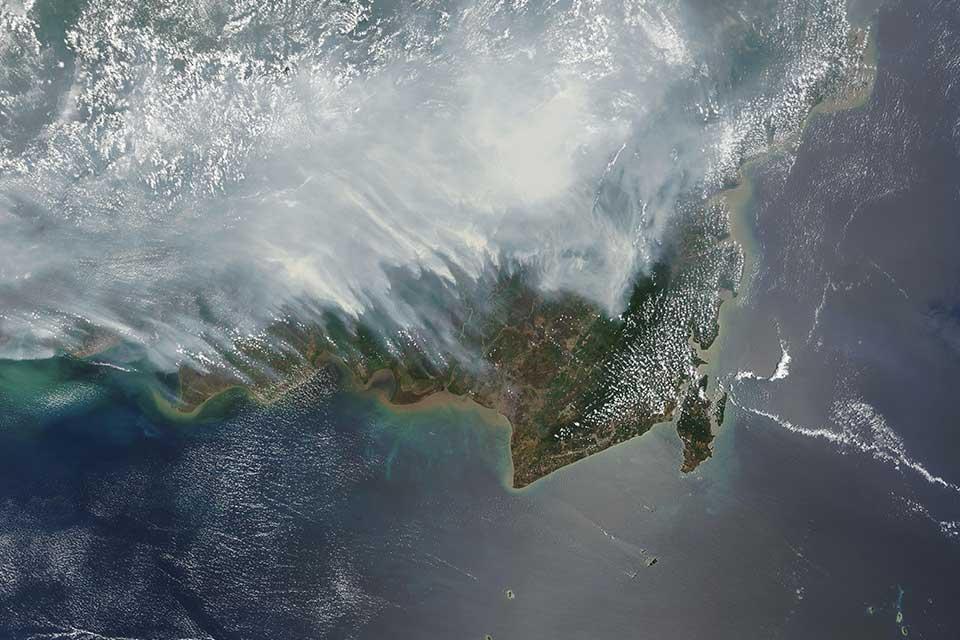Researchers from Oxford’s Department of Physics have developed a new understanding of how ‘absorbing aerosol’ (a by-product of wildfires and fossil-fuel burning) can change the climate. The research, led by DPhil student Andrew Williams, is published today in Nature Climate Change.
Human activities such as driving cars, flying planes or building factories are contributing to rapid changes in Earth’s climate. The primary driver of climate change is through the burning of fossil fuels and release of greenhouse gases (such as carbon dioxide or methane), which reduce the ease with which the Earth can lose energy to space and thus cause the planet to warm up. However, aside from greenhouse gases, human activities also generate large amounts of 'aerosol', which are tiny particles of dust and pollution suspended in the atmosphere. On average, aerosols cool the climate system and offset a significant part of the warming expected from greenhouse gases. As we remove aerosols to mitigate against air pollution, the climate system will experience additional warming.
Localised aerosol
The impacts of aerosol on climate are more poorly understood compared to our understanding of greenhouse gases because aerosol particles come in many different shapes and sizes, and can have very different chemical structures. Additionally, aerosol particles only stay in the atmosphere for a few weeks at a time, and so the spatial pattern of aerosol is very pronounced and varies regionally. On the other hand, the major greenhouse gases like carbon dioxide and methane get spread very evenly across the globe.
As it turns out, there is one particular type of aerosol which has posed a persistent problem to our understanding. These are termed 'absorbing aerosol' and are generally associated with either mineral dust or incomplete combustion of carbon-based fuel sources. The 'absorbing' refers to the fact that these types of aerosol absorb a significant fraction of the energy which comes from the sun, and thus act to warm the atmosphere locally. This localised warming alters the temperature of the atmosphere and also the winds, and these effects (coupled with the varied spatial pattern of the aerosol) have made it difficult to understand the basic physics by which absorbing aerosol changes the climate.
Understanding a complex issue
To make progress on this complex issue we have taken a highly-idealised approach and tried to reduce the problem down to its essence – how does Earth’s climate respond to localised solar absorption in different locations, and why? We used a state-of-the-art global climate model, added an idealised representation of the radiative impacts of absorbing aerosol and ran a large ensemble of experiments where we varied the geographical location of our aerosol perturbation.
Our results show that when absorbing aerosol is located in the midlatitudes and in regions of the tropics where air is descending, it has a modest warming influence on the planet. On the other hand, when absorbing aerosol is placed in regions of the tropics where air is ascending and where there are frequent thunderstorms, we find that the aerosol actually has a very strong cooling influence. We show that the reason for this difference in responses between midlatitudes/tropical descent regions and regions of tropical ascent is because of differences in the ways that the atmosphere responds to local warming.
A warming influence
When the aerosol (and the local warming) is placed in the midlatitudes, the atmosphere can efficiently balance this extra energy input by pulling colder air down from the polar regions. However, polar air also tends to be drier, which means that when the polar air is brought down to where the aerosol is, it dries out the atmosphere and makes it harder for clouds to form. This reduction in cloudiness slightly reduces the Earth’s albedo and causes a warming influence.
The cooling influence of absorbing aerosol in the tropics also hinges on the response of clouds. When absorbing aerosol is placed in regions of the tropics where the air is ascending, the extra warming tends to increase the energy available to convective clouds. This then warms the part of the tropical free-troposphere (the part of the atmosphere which is higher than about 3-5km), and a downstream impact of this is to generate more favourable conditions for clouds to form over the coasts of continents. So by similar reasoning to before, this corresponds to an increase in cloudiness, a subsequent increase in the Earth’s albedo and a cooling influence. These mechanisms are summarised below, in a schematic figure taken from our paper.
Understanding the basic physics
So, what have we gained? Firstly, we have shown that by taking an idealised approach to a complex question, you can make considerable progress in understanding the basic physics which governs the climate system and its response to aerosol forcing. Secondly, we have also demonstrated that the spatial pattern of aerosol (that is, where it is located geographically) is extremely important for determining its climate impact. In fact, the climatic changes can be completely different both in sign and magnitude depending on where the absorbing aerosol is located.
These results may well have real-world applications. In our paper, we use observations from the Aerosol Robotic Network (AERONET) to show that Indonesian wildfires could potentially be a good analogue for our idealised experiments. Since the 1980s, Indonesia has seen a sharp increase in the number and severity of intense wildfire seasons, and wildfires over this region are associated with strong absorbing aerosol perturbations due to their dense peatland soils (as can be seen in the accompanying NASA Worldview image). It is thus possible that these peatland wildfires could be important not just because of local health and air quality concerns, but also because of their impacts on Earth’s global energy balance.
Strong control of effective radiative forcing by the spatial pattern of absorbing aerosol, Andrew Williams et al, Nature Climate Change

